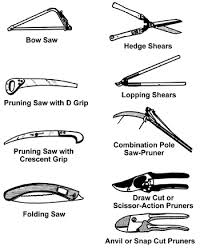

Calls to the Napa County Master Gardener help desk indicate that local gardeners need pruning advice. Many callers want to know when to prune, which is an excellent question. When shrubs fail to bloom, pruning at the wrong time is a likely cause.
Summer-and fall-flowering shrubs are generally pruned in winter when they are dormant. They flower on new wood that grows earlier in the same growing season. Pruning them back in late winter or early spring encourages more new growth and results in more flowers. Butterfly bush (Buddleia), honeysuckle (Lonicera fragrantissima) and rose of Sharon (Hibiscus syriacus) belong in this category. Many summer-flowering shrubs grow quickly and can take heavy pruning. I cut my Buddleias back every year to 10 to 12 inches, and they become six-foot giants again by the end of summer.
In contrast, spring-flowering shrubs bloom on old wood. That means they produce their flower buds on twigs that grew the previous summer. Although it is tempting to cut all shrubs back when doing your winter cleanup, resist that urge. Pruning spring-flowering shrubs in winter will eliminate most of their blooms.
In general, you should prune spring-flowering shrubs immediately after the flowers fade. Plants in this category include lilac (Syringa vulgaris), mock orange (Philadelphus) and viburnum (Viburnum spp.). Many spring-flowering plants do not need heavy pruning every year and are content with selective thinning to give them shape.
Hydrangeas present a pruning quandary. Some varieties bloom on old wood and others on new wood. Before taking pruning shears in hand, you need to identify the hydrangeas you have.
The large hydrangeas with blue or pink and sometimes white flowers (Hydrangea macrophylla) and oakleaf hydrangeas (Hydrangea quercifolia) both bloom on old wood. Prune them lightly right after flowering. The shrubs with white conical flowers (Hydrangea paniculata) and some of the other large-flowered hydrangeas (Hydrangea arborescens), such as the popular ‘Annabelle,’ bloom on new wood. Cut them back in late winter.
I have several Hydrangea macrophylla growing just outside my kitchen window. I once mistakenly cut them back severely in winter and the result was no blooms the following year. When I cut them back just after flowering, they bloom the following summer but the plants block much of the window before they finish blooming. So I am left with the dismal choice between glorious flowers and a view. This is the perfect example of wrong plant in the wrong place.
Regardless of when your shrubs bloom, you can prune them lightly anytime to remove damaged or diseased wood or to eliminate weak or unwanted growth. This clipping will safeguard the health of your shrub.
Improper pruning not only affects future blooms; it can also destroy the shape and health of the plant. Some gardeners have a tendency to create dense, round balls. Others top their plants or go for the lollipop look. It is best to respect the nature of the plant and prune judiciously.
One method is to cut branch by branch to shape the plant. Cut at branch unions or buds while avoiding shearing in a uniform hedge. Shearing is easier and faster but creates a shell of foliage, and the plants eventually become woody in the interior.
You can rejuvenate many types of shrubs by cutting them to the ground in early spring. However, you will sacrifice that year’s blooms on spring-blooming shrubs. Another method of rejuvenating an older shrub is to cut one third of the canes to the ground each year for three years until all canes have been rejuvenated. This practice works well on multi-stemmed twiggy shrubs.
We prune plants for many reasons: to control their size, maximize flowering, train them, improve their appearance and rejuvenate old, tired shrubs. Invest in a good pruning book, and prune each shrub according to its needs to avert a horticultural disaster.
Pruning is not always what a plant needs. Sometimes it’s wiser to just remove an overgrown plant and replace it with one more appropriate for the site. I intend to stop doing battle with the giant hydrangeas under my kitchen window and replace them with a more appropriate choice. Then I will have the luxury of both flowers and view.
Workshop: Napa County Master Gardeners will conduct a workshop on “Landscape Trees and Shade Gardens,” on Saturday, October 12, from 9:30 a.m. to 11:30 a.m., at University of California Cooperative Extension, 1710 Soscol Avenue, Napa. Wondering which trees do well in our valley and how to place them in your garden for years of shade and beauty? Learn which plants grow well under oaks and other trees, creating thriving shade gardens. Online registration (credit card only) Mail in registration (cash or check only). Sorry, no refunds unless workshop is cancelled.
Master Gardeners are volunteers who help the University of California reach the gardening public with home gardening information. Napa County Master Gardeners ( http://ucanr.org/ucmgnapa/) are available to answer gardening questions in person or by phone, Monday, Wednesday and Friday, 9 a.m. to Noon, at the U. C. Cooperative Extension office, 1710 Soscol Avenue, Suite 4, Napa, 707-253-4143, or from outside City of Napa toll-free at 877-279-3065. Or e-mail your garden questions by following the guidelines on our web site. Click on Napa, then on Have Garden Questions? Find us on Facebook under UC Master Gardeners of Napa County.